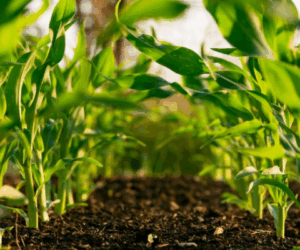1
Sweet potatoes are one of the most rewarding crops for home gardeners.
They are nutritious, versatile in the kitchen, and, surprisingly, quite easy to grow.
While many people associate sweet potatoes with sprawling vines that demand plenty of garden space, the truth is that they can thrive in containers just as well.
In fact, container gardening offers unique advantages—space management, frost protection, and the ability to start the growing season earlier.

With the right approach, even gardeners with limited space can look forward to a generous harvest.
Why Containers Make Sense
Traditional sweet potato varieties produce long, trailing vines that can quickly overtake a garden bed.
This makes them a challenge for people with small yards or only a balcony to work with.
However, by choosing compact, non-vining varieties such as Bunch Porto Rico or Vardaman, you can enjoy all the benefits of this crop without worrying about space constraints.
These varieties produce shorter vines that spill gracefully over container edges without dominating the entire growing area.
Another major benefit of container planting is temperature control. Sweet potato slips—the seedlings from which plants are grown—are highly sensitive to cold. Normally, gardeners have to wait until a month after the last frost to plant them in the ground.
But, containers give you a head start. By positioning them in a warm, sunny location—or even moving them indoors during cold nights—you can extend the growing season and maximise yield.
According to gardening expert, Travis Key of Lazy Dog Farm, sweet potatoes need roughly 90 to 120 days of warm weather to mature.
Starting early with containers can ensure that the plants enjoy enough heat to form healthy, delicious tubers.
Getting Started: Planting and Containers
Unlike regular potatoes, sweet potatoes are grown from slips rather than seed tubers.
You can buy slips from a nursery or grow your own by allowing a sweet potato to sprout in water or soil.
Once the slips emerge, they can be gently pulled off and transplanted into containers.
A general rule is to plant one slip per 10-gallon container, though larger containers can accommodate more.
The soil should be loose, fertile, and rich in organic matter. Good drainage is essential, as overly soggy soil can lead to rot.

Container size matters a great deal with root crops like sweet potatoes. Gardening educator Cindy Funes recommends using containers that are at least 18 inches deep and wide, though larger is even better.
For multiple plants, troughs or fabric grow bags measuring about 36 inches long allow each slip to enjoy sufficient space.
Fabric grow bags are especially popular because of their excellent drainage and the ability to check tuber development through built-in flaps.
Caring For Container-Grown Sweet Potatoes
Once planted, sweet potatoes need consistent care over their long growing season.
Fortunately, container cultivation allows for more precise control of soil, water, and sunlight.
Sunlight: Sweet potatoes thrive in full sun. Aim for at least six hours of direct light daily, though eight or more is preferable for strong growth.
Watering: Containers dry out more quickly than garden soil, so regular watering is crucial.
The goal is to keep the soil moist but not waterlogged. Good drainage holes are non-negotiable.
Soil: A light, sandy soil enriched with compost is ideal. Avoid heavy clay soils unless they are well amended with organic matter.
Fertiliser: Unlike leafy greens, sweet potatoes don’t benefit much from nitrogen-heavy fertilizers.
Too much nitrogen will produce abundant vines but small tubers. Instead, focus on balanced nutrients, with a preference for phosphorus and potassium, which promote root development.
Managing Vines and Growth
Sweet potatoes are vigorous growers, and even compact varieties can send vines spilling out of their containers.
While it may be tempting to trim them back, the leaves play a vital role in photosynthesis, providing the energy the plant needs to form tubers.
Light pruning for convenience is fine, but avoid heavy cutting if you want a robust harvest.
One of the advantages of container growing is mobility. If you live in a cooler climate, you can move the containers to protect plants from early frost.
They also handle summer heat exceptionally well, making them a great mid-summer crop when other vegetables may struggle.
Dealing with Pests
Container-grown sweet potatoes are not immune to pests, but they are generally easier to manage than field-grown crops. Some common threats include whiteflies, flea beetles, cutworms, leafhoppers, and the notorious sweet potato weevil.
Regular monitoring and prompt intervention can prevent infestations from spreading. Because containers are more contained ecosystems, organic control methods—like insecticidal soap or neem oil—are often sufficient.
Harvesting For The Best Flavour
Sweet potatoes are typically ready to harvest after about three to four months, depending on the variety.
The best time to dig them up is when the leaves start to yellow, signaling that the tubers have matured. When harvesting, handle the tubers carefully, as their skins are delicate and can bruise easily.
After harvesting, curing the sweet potatoes for about one to two weeks in a warm, humid environment will improve both their sweetness and storage life.
Properly cured sweet potatoes can last for months, making them a rewarding crop for long-term use.
Last Line
Growing sweet potatoes in containers offers a practical, space-saving, and rewarding way to enjoy this nutritious crop.
From managing soil temperature to keeping pests at bay, containers give gardeners a high degree of control over the growing environment.
With the right container size, careful watering, and proper variety selection, anyone—from apartment dwellers to backyard gardeners—can enjoy a bountiful harvest.
Sweet potatoes are not just a crop for large farms; they can just as easily thrive on your balcony, patio, or even doorstep.








